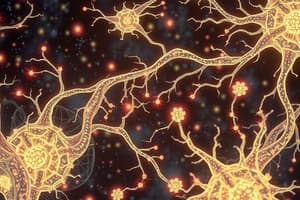Podcast
Questions and Answers
What is the resting membrane potential (RMP) usually in neurons?
What is the resting membrane potential (RMP) usually in neurons?
-70 mV
Which of the following contribute to the resting membrane potential? (Select all that apply)
Which of the following contribute to the resting membrane potential? (Select all that apply)
- Sodium-potassium pump (correct)
- ICF non-diffusible anions (correct)
- Calcium influx
- Potassium efflux (correct)
What does the Goldman equation calculate?
What does the Goldman equation calculate?
Resting membrane potential (RMP)
What is the threshold potential for an action potential?
What is the threshold potential for an action potential?
The Na+/K+ ATPase pump plays a role in the depolarization and repolarization phases of the action potential.
The Na+/K+ ATPase pump plays a role in the depolarization and repolarization phases of the action potential.
During depolarization, there is an influx of ______ ions into the cell.
During depolarization, there is an influx of ______ ions into the cell.
What causes the rapid repolarization during an action potential?
What causes the rapid repolarization during an action potential?
What happens during the hyperpolarization phase?
What happens during the hyperpolarization phase?
What is the role of voltage-gated Na+ channels during the action potential?
What is the role of voltage-gated Na+ channels during the action potential?
What is the primary effect of opening voltage-gated K+ channels?
What is the primary effect of opening voltage-gated K+ channels?
Flashcards are hidden until you start studying
Study Notes
Resting Membrane Potential (RMP)
- The RMP is the difference in potential across the cell membrane, usually around -70mV in neurons
- Caused by a combination of factors:
- Potassium efflux: Potassium ions are more permeable and move out of the cell, making the inside more negative.
- Sodium-potassium pump: Actively pumps 3 sodium ions out of the cell for every 2 potassium ions pumped in, contributing to the negative charge inside.
- Non-diffusible anions: Negatively charged molecules within the cell that can't cross the membrane, contributing to the negative charge.
- RMP magnitude varies between cells:
- Skeletal and cardiac muscles: -90mV
- Nerve cells: -70mV
- The Goldman-Hodgkin-Katz equation calculates RMP based on ion concentrations and permeabilities.
Action Potential
- Characterized by rapid changes in membrane potential in excitable tissues like muscles and nerves.
- Components:
- Polarization: Resting state where the inside is negative compared to the outside.
- Depolarization: Inside becomes more positive than the outside due to sodium influx.
- Repolarization: Inside becomes more negative than the outside due to potassium efflux, returning towards RMP.
Ionic Basis of the Action Potential
- Voltage-gated sodium and potassium channels are responsible for the action potential events:
- Threshold potential: The depolarization level that triggers opening of both sodium and potassium channels.
- Fast sodium channels: Open rapidly and close quickly, allowing rapid sodium influx.
- Slower potassium channels: Open slowly and close with a delay, allowing potassium efflux.
Depolarization Phase
- Sodium channels open, increasing sodium conductance, allowing sodium influx.
- Inside of the cell becomes less negative due to sodium entering.
Repolarization Phase
- Potassium channels open, allowing potassium efflux.
- Potassium leaves the cell, making the inside more negative and causing repolarization.
After-hyperpolarization
- Slow closing of potassium channels leads to hyperpolarization because potassium continues to leave the cell.
- The membrane gradually returns to RMP as potassium permeability returns to normal.
The Role of Na+/K+ ATPase Pump in Action Potential
- The Na+/K+ ATPase pump doesn't play a role in depolarization, repolarization, or returning to RMP.
- However, it maintains ion concentration gradients that are essential for the action potential:
- Sodium influx during depolarization increases intracellular sodium.
- Potassium efflux during repolarization decreases intracellular potassium.
- The Na+/K+ ATPase pump restores these ions to their normal intracellular concentrations, ensuring the action potential can happen repeatedly.
Studying That Suits You
Use AI to generate personalized quizzes and flashcards to suit your learning preferences.




